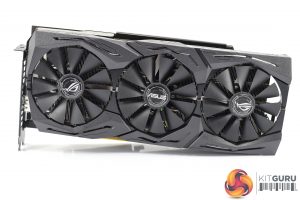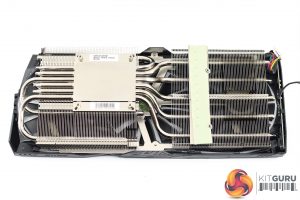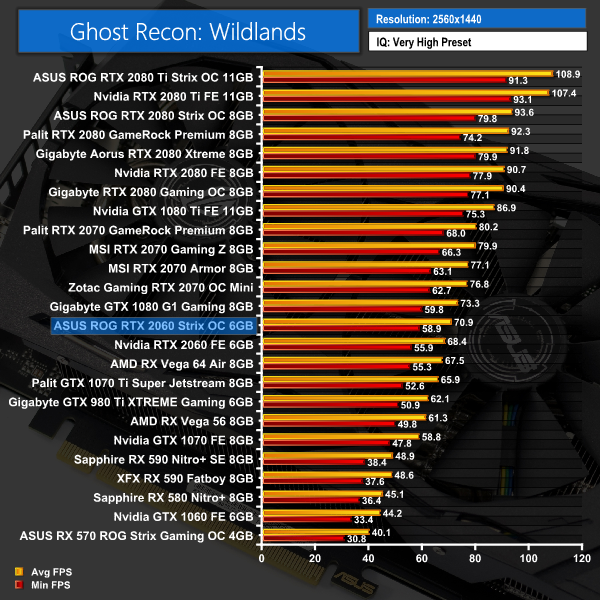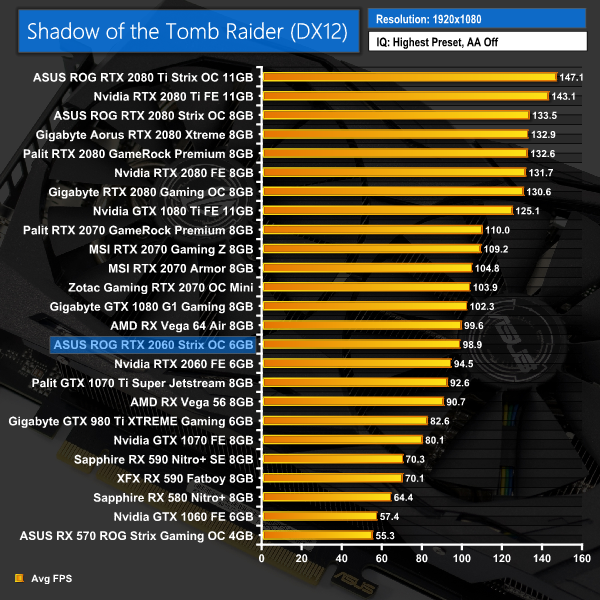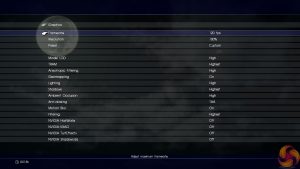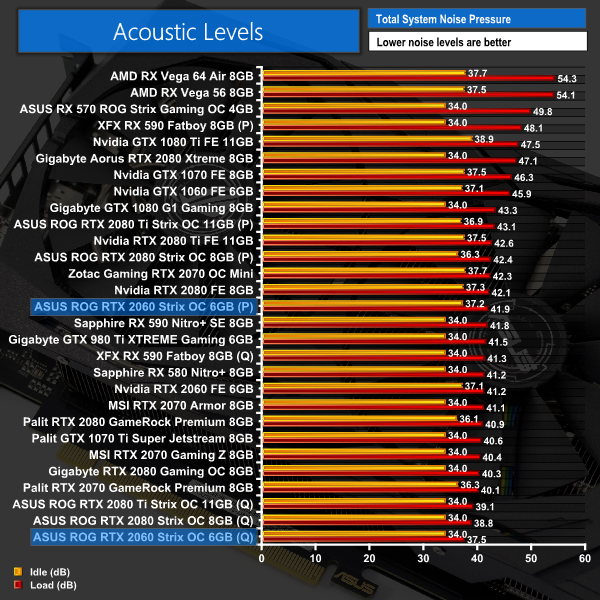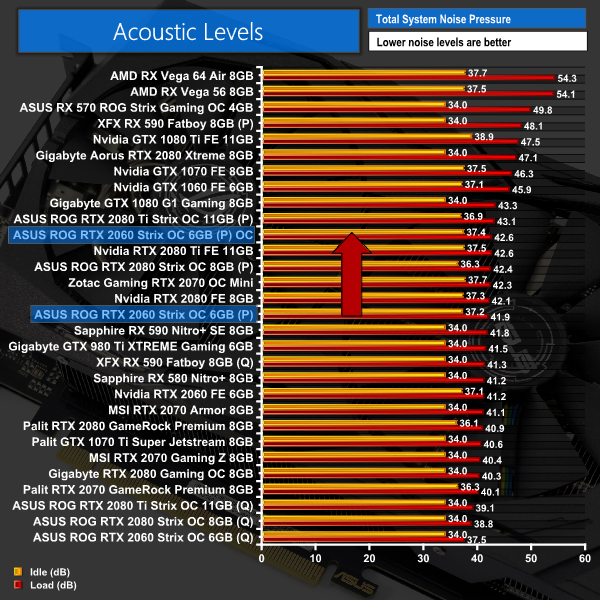
Today marks a week since the launch of Nvidia's RTX 2060 Founders Edition graphics card, and the latest addition to the Turing family has been generally well received – at £329, it's still not a budget option, but there is finally a more affordable card in the RTX 20-series line up.
We've already seen what the Founders card can do, though, so what about a factory overclocked custom card? That's exactly what we're focusing on today, with a look at the ASUS ROG RTX 2060 Strix OC – a triple-fan aftermarket RTX 2060 solution with a boost clock of 1830MHz. Is this a better buy than Nvidia's Founders Edition card?
Unlike the other RTX 20-series cards, Nvidia's RTX 2060 Founders Edition is not a factory overclocked model – it ships with the reference boost clock of 1680MHz. That means it is up to Nvidia's partners to ship factory overclocked models which push the boundaries of what a 2060 is capable of. This ASUS ROG RTX 2060 Strix OC, for instance, has an 1830MHz boost clock – but you can increase this to 1860MHz by enabling ‘OC Mode' within ASUS' GPU Tweak II software.
On top of that, there are also plenty of features to talk about – including dual-BIOS functionality, the triple-fan cooler and even an on-board Aura RGB header for connecting other RGB devices. With ASUS' MSRP coming in at £455, though, are you getting a good deal?
| GPU | RTX 2080 (FE) | GTX 1080 | RTX 2070 (FE) | GTX 1070 | RTX 2060 (FE) | GTX 1060 |
| SMs | 46 | 20 | 36 | 15 | 30 | 10 |
| CUDA Cores | 2944 | 2560 | 2304 | 1920 | 1920 | 1280 |
| Tensor Cores | 368 | N/A | 288 | N/A | 240 | N/A |
| Tensor FLOPS | 85 | N/A | 63 | N/A | 51.6 | N/A |
| RT Cores | 46 | N/A | 36 | N/A | 30 | N/A |
| Texture Units | 184 | 160 | 144 | 120 | 120 | 80 |
| ROPs | 64 | 64 | 64 | 64 | 48 | 48 |
| Rays Cast | 8 Giga Rays/sec | 0.877 Giga Rays/sec | 6 Giga Rays/sec | 0.65 Giga Rays/sec | 5 Giga Rays/sec | 0.44 Giga Rays/sec |
| RTX Performance | 60 Trillion RTX-OPS | 8.9 Trillion RTX-OPS | 45 Trillion RTX-OPS | 6.5 Trillion RTX-OPS | 37 Trillion RTX-OPS | N/A |
| GPU Boost Clock | 1800 MHz | 1733 MHz | 1710 MHz | 1683 MHz | 1680 MHz | 1708 MHz |
| Memory Data Rate | 14 Gbps | 10 Gbps | 14 Gbps | 8 Gbps | 14 Gbps | 8 Gbps |
| Total Video Memory | 8GB GDDR6 | 8GB GDDR5X | 8GB GDDR6 | 8GB GDDR5 | 6GB GDDR6 | 6GB GDRR5 |
| Memory Interface | 256-bit | 256-bit | 256-bit | 256-bit | 192-bit | 192-bit |
| Memory Bandwidth | 448 GB/sec | 320 GB/sec | 448 GB/sec | 256 GB/sec | 336.1 GB/sec | 192 GB/sec |
| TDP | 225W | 180W | 185W | 150W | 160W | 120W |
As mentioned, the ASUS ROG RTX 2060 Strix OC is capable of an 1860MHz boost clock – enabled by choosing OC Mode in the GPU Tweak II software. This gives the Strix an effective clock speed advantage of 180MHz over the Founders Edition, and this is the mode we used when testing the card.
Other than that, though, the core specs are all the same as a reference 2060 – meaning we have the same 1920 CUDA cores, 240 Tensor cores and 30 RT cores. It is also worth noting the 6GB GDDR6 memory hasn't been overclocked out of the box.

The ASUS ROG RTX 2060 Strix OC ships in a a very familiar-looking box – the ROG logo is printed in bright neon colours, with an image of the card itself positioned on the left hand side of the box.
There isn't a whole lot in the way of accessories, as inside we find a quick start guide, a driver disk and then two Velcro cable ties.
Getting our first look at the card, it is an immediately familiar design – having already reviewed the Strix 2080 and 2080 Ti cards, all three share the same matte black shroud and each come with triple fan cooling configurations.
That being said, this Strix 2060 arguably looks more like the previous gen Strix GTX 1080 Ti. That's because, unlike the 2080 and 2080 Ti Strix models, this 2060 uses ASUS' older ‘wing blade' fans, when the newer models use the ‘axial-tech fans' which sport those rings running around the edge of the fans.
We asked ASUS why they made this decision, and were told that the fan design is ‘dictated by the needs of the GPU' – essentially suggesting that the 2060 is a much easier chip to cool than a 2080, for instance, thus ASUS doesn't need to use the presumably more expensive axial-tech fans to ensure good temperatures.
Despite the Founders 2060 being quite a compact card, ASUS has gone the opposite direction and in typical Strix fashion this card is huge. That's because it measures 30.00 x 13.20 x 5.00 cm – making it over 7cm longer than the Founders Edition.
As a 2.5-slot card, though, it is not quite as thick as the other Strix 20-series cards we have seen – those are 2.7-slot cards, but regardless you will need a big case to ensure this 2060 will fit.
Opening the card up is as simple as removing six screws from the backplate. Then we get a look at the PCB and the metal frame that is actually screwed onto the PCB to improve structural rigidity as well as cool the six GDRR6 memory chips. Removing that is a simple case of unscrewing the frame from the backplate and I/O bracket.
With that out of the way, there are a few things worth pointing out about the PCB. The first is the beefed up power delivery which comprises 8+2 power phases – up from 6+2 with the Founders 2060. On top of that, we can see that the TU106 GPU that ASUS is using here is indeed a binned chip – it is labelled ‘TU106-200A', and it is the ‘A' which denotes this GPU can be sold with a factory overclock.
Elsewhere, the 6GB GDDR6 memory is also worth noting – this is from Micron and the chips are labelled ‘DTA77D9WCW'. At the end of the PCB, we find an additional three 4-pin headers. Two of these are PWM fan headers which will control your system fans based on the graphic card's temperature instead of your CPU's temperature. The other header is a 4-pin ASUS Aura RGB connector which will let you plug in additional RGB devices to the graphics card itself.
As for the heatsink, this is a hefty unit with a total of 6 heatpipes, with each measuring 6mm in diameter. These feed through a chunky fin array, while the GPU die contacts with a coldplate. This uses ASUS MaxContact technology, which the company says allows it to be up to 10x flatter than other coldplates, ensuring greater contact between the GPU die and the metal – thus ensuring greater thermal transfer. We test thermal performance later in the review.
On the front side of the card, we can note the ‘GeForce RTX' branding which is printed onto the metal frame we mentioned earlier. Just above that, however, we also find a dual-BIOS switch – as with other Strix cards from this generation, this lets users choose between the ‘performance’ BIOS or the ‘quiet’ BIOS. The only change is the fan curve is drastically reduced when using the card with its quiet BIOS, as clock speed remains the same. This is something we test later in the review.
In terms of the backplate, this is the same brushed metal design we have seen before from ASUS, with the owl eye logo on the right hand side also acting as one of the card's RGB zones. There is also a master power button for the RGB lighting positioned just to the right of the dual-BIOS switch, and a press of this turns all the lighting on or off.
Other things to mention include the 1x 8-pin and 1x 6-pin PCIe power requirements. and of course we test power consumption later in the review.
Lastly, display outputs consist of 2x DisplayPort 1.4 and 2x HDMI 2.0b, but no DVI or USB-C connectors.
Our newest GPU test procedure has been built with the intention of benchmarking high-end graphics cards. We test at 1920×1080 (1080p), 2560×1440 (1440p), and 3840×2160 (4K UHD) resolutions.
We try to test using the DX12 API if titles offer support. This gives us an interpretation into the graphics card performance hierarchy in the present time and the near future, when DX12 becomes more prevalent. After all, graphics cards of this expense may stay in a gamer’s system for a number of product generations/years before being upgraded.
We tested the RX Vega64 and Vega56 using the ‘Turbo‘ power mode in AMD’s WattMan software. This prioritises all-out performance over power efficiency, noise output, and lower thermals.
As mentioned, we are testing the Strix using the OC Mode which can be enabled within GPU Tweak II – this means the card has a rated boost clock of 1860MHz.
Driver Notes
We are currently re-testing our graphics cards with the latest drivers, but for now here is the configuration as presented:
- All AMD graphics cards were benchmarked with the Adrenalin 18.11.1 driver.
- Nvidia graphics cards (apart from RTX 20 series cards) were benchmarked with the Nvidia 399.24 driver.
- RTX 2080 and 2080 Ti cards were benchmarked with the Nvidia 411.63 driver.
- RTX 2070 cards were benchmarked with the Nvidia 416.33 driver.
- RTX 2060 was benchmarked with the Nvidia 417.54 driver supplied to press ahead of launch.
Test System
We test using the Overclockers UK Germanium pre-built system. You can read more about it over HERE. It is important to note we have had to re-house the components to an open-air test bench to accommodate our new GPU power testing (more on that later) but the core of the system is unchanged and the performance figures you see presented here are what you can expect from the Germanium.
| CPU |
Intel Core i7-8700K
Overclocked to 4.8GHz |
| Motherboard |
ASUS ROG Strix Z370-F Gaming
|
| Memory |
Team Group Dark Hawk RGB
16GB (2x8GB) @ 3200MHz 16-18-18-38 |
| Graphics Card |
Varies
|
| System Drive |
Patriot Wildfire 240GB
|
| Games Drive | Crucial M4 512GB |
| Chassis | Streacom ST-BC1 Bench |
| CPU Cooler |
OCUK TechLabs 240mm AIO
|
| Power Supply |
SuperFlower Leadex II 850W 80Plus Gold
|
| Operating System |
Windows 10 Professional
|
Comparison Graphics Cards List
- Nvidia RTX 2080 Ti Founders Edition (FE) 11GB
- ASUS ROG RTX 2080 Ti Strix 11GB
- Nvidia RTX 2080 Founders Edition (FE) 8GB
- Gigabyte RTX 2080 Gaming OC 8GB
- Palit RTX 2080 GameRock Premium 8GB
- ASUS ROG RTX 2080 Strix OC 8GB
- Gigabyte Aorus RTX 2080 Xtreme 8GB
- MSI RTX 2070 Gaming Z 8GB
- MSI RTX 2070 Armor 8GB
- Palit RTX 2070 GameRock Premium 8GB
- Zotac RTX 2070 OC Mini 8GB
- Nvidia RTX 2060 Founders Edition (FE) 6GB
- Nvidia GTX 1080 Ti Founders Edition (FE) 11GB
- Gigabyte GTX 1080 G1 Gaming 8GB
- Palit GTX 1070 Ti Super Jetstream 8GB
- Nvidia GTX 1070 Founders Edition (FE) 8GB
- Nvidia GTX 1060 Founders Edition (FE) 6GB
- Gigabyte GTX 980 Ti XTREME Gaming 6GB
- AMD RX Vega 64 Air 8GB
- AMD RX Vega 56 8GB
- Sapphire RX 590 Nitro+ Special Edition (SE) 8GB
- XFX RX 590 Fatboy 8GB
- Sapphire RX 580 Nitro+ 8GB
- ASUS RX 570 ROG Strix Gaming OC 4GB
Where a card has been tested using both on-board BIOS profiles, a (P) at the end of the name indicates use of the Performance BIOS, and a (Q) at the end of the name indicates use of the Quiet BIOS.
Software and Games List
- 3DMark Fire Strike & Fire Strike Ultra (DX11 Synthetic)
- 3DMark Time Spy (DX12 Synthetic)
- 3DMark Port Royal (DXR Synthetic)
- Deus Ex: Mankind Divided (DX12)
- Far Cry 5 (DX11)
- Tom Clancy’s Ghost Recon: Wildlands (DX11)
- Middle Earth: Shadow of War (DX11)
- Shadow of the Tomb Raider (DX12)
- Battlefield V w/ RTX (DX12)
- Final Fantasy XV w/ DLSS (DX11)
We run each benchmark/game three times, and present averages in our graphs.3DMark Fire Strike is a showcase DirectX 11 benchmark designed for today’s high-performance gaming PCs. It is our [FutureMark’s] most ambitious and technical benchmark ever, featuring real-time graphics rendered with detail and complexity far beyond what is found in other benchmarks and games today.
It's a very good start for the ROG Strix RTX 2060 – it comfortably beats Nvidia's Founders Edition RTX 2060 across every 3DMark test, and even nudges ahead of the GTX 1080 in the DX12 Time Spy test.3DMark Port Royal is the world’s first dedicated real-time ray tracing benchmark for gamers. You can use Port Royal to test and compare the real-time ray tracing performance of any graphics card that supports Microsoft DirectX Raytracing. As well as benchmarking performance, 3DMark Port Royal provides a realistic and practical example of what to expect from ray tracing in upcoming games.
Here we have a new addition to our benchmarking suite – the newly announced 3DMark Port Royal, designed specifically as a ray tracing benchmark. Given this was only released on the 8th January 2019, we have not been able to use it in reviews until now. That means we have a smaller crop of comparison cards, but we can still see ASUS' Strix 2060 outperforming Nvidia's Founders Edition by over 200 points.Deus Ex: Mankind Divided is set in the year 2029, two years after the events of Human Revolution and the “Aug Incident”—an event in which mechanically augmented humans became uncontrollable and lethally violent. Unbeknownst to the public, the affected augmented received implanted technology designed to control them by the shadowy Illuminati, which is abused by a rogue member of the group to discredit augmentations completely. (Wikipedia).
We test using the Very High preset, with MSAA disabled. We use the DirectX 12 API.
In Deus Ex: Mankind Divided, not only does the Strix 2060 outperform Nvidia Founders 2060 – but it is also faster than the GTX 1070 Ti across all three resolutions.Far Cry 5 is an action-adventure first-person shooter game developed by Ubisoft Montreal and Ubisoft Toronto and published by Ubisoft for Microsoft Windows, PlayStation 4 and Xbox One. It is the eleventh entry and the fifth main title in the Far Cry series, and was released on March 27, 2018.
The game takes place in the fictional Hope County, Montana, where charismatic preacher Joseph Seed and his cult Project at Eden’s Gate holds a dictatorial rule over the area. The story follows an unnamed junior deputy sheriff, who becomes trapped in Hope County and works alongside factions of a resistance to liberate the county from Eden’s Gate. (Wikipedia).
We test using the Ultra preset, with AA and motion blur disabled.
In Far Cry 5, this overclocked Strix 2060 actually comes very close to matching the performance of the Zotac RTX 2070 OC Mini. Admittedly, that Zotac is the slowest RTX 2070 we have tested to-date, but even then – the Strix 2060 is doing very well to push out frame rates that are only marginally slower.Tom Clancy’s Ghost Recon Wildlands is a tactical shooter video game developed by Ubisoft Paris and published by Ubisoft. It was released worldwide on March 7, 2017, for Microsoft Windows, PlayStation 4 and Xbox One, as the tenth installment in the Tom Clancy’s Ghost Recon franchise and is the first game in the Ghost Recon series to feature an open world environment. (Wikipedia).
We test using the Very High preset.
ASUS' RTX 2060 Strix continues to outperform its Founders Edition cousin when we come to Ghost Recon: Wildlands, with the gap between the two almost 5FPS at 1080p resolution.Middle-earth: Shadow of War is an action role-playing video game developed by Monolith Productions and published by Warner Bros. Interactive Entertainment. It is the sequel to 2014’s Middle-earth: Shadow of Mordor, and was released worldwide for Microsoft Windows, PlayStation 4, and Xbox One on October 10, 2017. (Wikipedia).
We test using the Very High preset.
With Middle Earth: Shadow of War, we again see the Strix 2060 perform well – at 1080p and 4K, for instance, the card is able to outperform the GTX 1080, which is no mean feat.Shadow of the Tomb Raider is an action-adventure video game developed by Eidos Montréal in conjunction with Crystal Dynamics and published by Square Enix. It continues the narrative from the 2013 game Tomb Raider and its sequel Rise of the Tomb Raider, and is the twelfth mainline entry in the Tomb Raider series. The game released worldwide on 14 September 2018 for Microsoft Windows, PlayStation 4 and Xbox One. (Wikipedia).
We test using the Highest preset, with AA disabled. We test using the DX12 API.
Our last traditional game of the day, Shadow of the Tomb Raider again shows the Strix 2060 to have a considerable lead over the Nvidia Founders model. At 1080p, for instance, the Strix is 4.4FPS faster, while the gap between the two is 3.3FPS at 1440p.Battlefield V is a first-person shooter video game developed by EA DICE and published by Electronic Arts. Battlefield V is the sixteenth installment in the Battlefield series. It was released worldwide for Microsoft Windows, PlayStation 4, and Xbox One on November 20, 2018. (Wikipedia).
We test using the Ultra preset with the DX12 API. Battlefield V is the first game released with Nvidia RTX ray tracing features (called DXR in game) and we present average and minimum frame rates for the game with DXR Off, and then again with DXR set to Ultra.
Now we come to Battlefield V and ray tracing. Despite this ASUS model outperforming the Founders card across every test here, I would still suggest 1080p is the limit for the RTX 2060 with ray tracing enabled.
At that resolution, the Strix was able to run at 75FPS on average with DXR Ultra – just over 3FPS faster than the Founders 2060. When the resolution is increased to 1440p, even though the Strix maintained higher minimum frame rates than what we saw from the FE 2060, I still found frame rate drops to be just a bit too noticeable for a satisfying gaming experience.Final Fantasy XV is an action role-playing game developed and published by Square Enix as part of the long-running Final Fantasy series. It was released for the PlayStation 4 and Xbox One in 2016, and for Microsoft Windows in 2018. (Wikipedia).
We are testing FFXV as it is the first full title – and currently only title – that supports Nvidia’s AI-assisted DLSS anti-aliasing technique. Currently the game only supports DLSS when playing at 4K, so we benchmarked a section of the game with TAA on, and then with DLSS on to see the performance difference. We used the ‘Highest’ preset, but turned off other Nvidia technologies like HairWorks.
As expected, with FFXV the Strix 2060 outperforms the Nvidia Founders Edition 2060 – be it with TAA or DLSS enabled. DLSS still only works at 4K with FFXV, so it's not an ideal situation for either RTX 2060 card, but we can still see average frame rate jumping by almost 10FPS when we switch from TAA to DLSS.Here we present the average clock speed for each graphics card while running the 3DMark Fire Strike Ultra stress test 20 times. We use GPU-Z in tandem with the Powenetics Project to record the GPU core frequency during the Fire Strike Ultra runs – at the end, we are left with around 4300 data entries.
We calculate the average core frequency during the entire 20-run test to present here.
Even when considering that we tested with OC Mode enabled – thus raising the default clock speed by 30MHz – I was still very impressed to see this Strix 2060 operate with an average frequency of over 2GHz. Many cards can't run that fast even when manually overclocked, so ASUS has clearly delivered this RTX 2060 right at the upper limit of its frequency range, so you're getting plenty of extra performance out of the box – as we have seen throughout our games tests when comparing the Strix to the Founders Edition, this card is consistently the faster of the two.For our temperature testing, we measure the peak GPU core temperature under load, as well as the GPU temperature with the card idling on the desktop. A reading under load comes from running the 3DMark Fire Strike Ultra stress test 20 times. An idle reading comes after leaving the system on the Windows desktop for 30 minutes.
I was always expecting thermal performance from the Strix 2060 to be good – but not this good. With the performance BIOS, the card didn't run hotter than 55C under load which is simply fantastic. Even when using the quiet BIOS, which runs the fans significantly slower, the temperature topped out at 61C. That just goes to show, if you stick a big cooler with a triple fan setup on a RTX 2060, you are going to get very impressive thermal results.
The low temperatures continue when we look at the card with our thermal imaging camera. Here, the hottest spot on the card itself didn't even reach 54C, which only goes to show how well the Strix cooler is able to disperse the heat produced by the card.We take our noise measurements with the sound meter positioned 1 foot from the graphics card. I measured the sound floor to be 34 dBA, thus anything above this level can be attributed to the graphics cards. The power supply is passive for the entire power output range we tested all graphics cards in, while all CPU and system fans were disabled.
A reading under load comes from running the 3DMark Fire Strike Ultra stress test 20 times. An idle reading comes after leaving the system on the Windows desktop for 30 minutes.
Part of the reason for the performance BIOS' extremely low temperatures is the fact it does run the fans slightly faster than most other RTX 20-series cards we have tested. It is still not loud – peaking at just under 42dB – but it is more audible than the Founders Edition.
The quiet BIOS, however, is simply incredible. It's the lowest noise reading I've ever seen from a graphics card and it's at the point where you'd have to press your ear very close to the card to be able to hear if the fans are actually spinning. It's hugely impressive stuff from ASUS.We have recently revamped our GPU power consumption testing. Previously we would measure the total system power draw with each graphics card installed. Given that the rest of the components did not change, this gave us an idea of the relative power consumption of each graphics card, but we could not be more specific than that.
Now, however, thanks to Cybenetics Labs and its Powenetics Project, we are able to measure the power consumption of the graphics card alone, giving much more precise and accurate data. Essentially, this works by installing sensors in the PCIe power cables, as well as the PCIe slot itself thanks to a special riser card. This data is recorded using specialist software provided by Cybenetics Labs and given it polls multiple times a second (between 6 and 8 times a second, based on my observations) we can track the power consumption in incredible detail over any given amount of time.
You can read more about the Powenetics Project over HERE.
Note: if the above images are not displaying properly, you may need to disable your ad block software as they are known to interfere with our display code.
As with previous testing, a reading under load comes from running the 3DMark Fire Strike Ultra stress test 20 times. An idle reading comes after leaving the system on the Windows desktop for 30 minutes. This stress test (20 runs) produces approximately 4300 data entries in the Powenetics software, which we can then export to an Excel file and analyse further. Here we present the average continuous power consumption of each graphics card across the entire 20 run test.
As expected considering this is a heavily factory overclocked card, the Strix 2060 draws about 30W more than Nvidia's Founders Edition card. That puts total power draw at around the 190W mark, with essentially nothing to split the two BIOS modes in terms of power consumption.
To overclock the Strix 2060, we used ASUS GPU Tweak II. We were able to add an extra 35MHz to the GPU core (on top of the extra 30MHz provided by the OC Mode preset), and 750MHz to the GDDR6 memory.
3DMark and games testing
Given this card is already running very fast out of the box, it is not a huge surprise that manual overclocking headroom is limited. That means we didn't see much performance benefit from the extra frequency, with an extra 2.5FPS in Shadow of the Tomb Raider being about as good as it got.Here, we take a further look at the impact of our overclock, looking at the increased temperatures, acoustics, power draw, and lastly, the effect had on the average clock speed.
Temperatures
Acoustics
Power consumption
Average clock speed under load
Overview
As the overclock was not very significant at all, we didn't see much extra heat or noise from the card. In fact, the peak GPU temperature stayed at 55C – so the card didn't run any hotter with this small overclock applied versus stock – and noise levels did not even rise 1dB.
Power consumption, too, was barely affected, with total power draw rising by under 6W.
A week on from the launch of the Founders Edition RTX 2060, today we have been able to test our first aftermarket RTX 2060 card in the form of the ASUS ROG RTX 2060 Strix OC. I have to say, it is probably one of the finest graphics cards I have ever tested. This is only part of the conclusion however.
A big part of its appeal is the raw clock speed ASUS has been able to deliver with the Strix 2060. We saw it average over 2GHz under load, giving it a real-world clock speed advantage of about 180MHz over the Founders Edition. This means it performs a good amount faster in games, being on average 5.1% faster than the Founders Edition at 1080p, and 4.5% faster on average at 1440p.
On top of that, the dual-BIOS functionality – a staple of ASUS ROG's RTX 20-series Strix cards – gives the card some real versatility depending on whether you want low temperatures or low noise levels. With the performance BIOS, for instance, I did not see my card run hotter than 55C – while switching to the quiet BIOS means noise output becomes essentially inaudible.
Other features we have come to expect from ASUS' high-end cards are also present, including the impressive 3-zone RGB lighting, stealthy matte black shroud design, while there are also additional fan and RGB headers placed on the Strix's PCB.
It's simply an all-round excellent graphics card. The one area where it didn't do so well was when we came to manual overclocking – but considering it was already running at over 2GHz before we started doing any manual tinkering, this is less of an issue for the Strix than it would be for a slower card.
By far and away the main thing holding this card back, however, is pricing. ASUS is simply pushing some very high prices for its RTX 20-series cards, and it really does hurt them. We're writing this before any official retail listings have gone live with confirmed pricing, but having spoken with ASUS we have been told the MSRP for this card is £455.
I'm sorry ASUS, but as good as your card is, that is just silly. It's more expensive than even some RTX 2070 models, and as fast as it is for a 2060, it's still not as fast as a 2070.
That means I can only recommend this card in good faith if you find it on offer at a more reasonable price. Even at £400 – which is still a lot for an RTX 2060 when you consider that the Founders Edition is £329 – I think this card would do well as it is just an all-round excellent option. When its priced higher than some RTX 2070s, though, something has definitely gone wrong.
We don't yet have a buy-link for the ASUS ROG RTX 2060 Strix OC but we will update this review when we have one.
Update: The Strix 2060 is now available for pre-order from Overclockers UK for £469.99 HERE.
Pros
- Average operating frequency was over 2GHz.
- Peak temperature of just 55C using the performance BIOS.
- Quiet BIOS is practically inaudible.
- Effective RGB implementation.
- Extra on-board RGB and fan headers.
- Stealthy matte black shroud.
Cons
- Limited manual overclocking headroom.
- MSRP is more than some RTX 2070s on the market.
KitGuru says: The ASUS ROG RTX 2060 Strix OC is probably the finest graphics card I have ever tested. However, when you take an RTX 2060 and price it like an RTX 2070, it just doesn't make any sense from a consumer standpoint. As it is, I can only recommend this card if you find it on sale with a lower price.
 KitGuru KitGuru.net – Tech News | Hardware News | Hardware Reviews | IOS | Mobile | Gaming | Graphics Cards
KitGuru KitGuru.net – Tech News | Hardware News | Hardware Reviews | IOS | Mobile | Gaming | Graphics Cards





